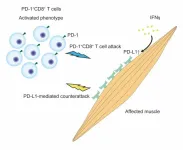(Press-News.org) People who live in neighborhoods with higher levels of poverty and unemployment are less likely to fill their heart-failure drug prescriptions than those living in wealthier areas, a new study shows. The findings not only add to understanding geographic and economic disparities in heart disease care, but also point to new ways to address barriers for patients taking these lifesaving drugs.
Led by researchers at NYU Grossman School of Medicine, the study explored prescription pickup patterns among patients with systolic heart failure, a chronic, life-threatening condition in which the muscles of the heart weaken and lose their ability to pump blood effectively. Past research has shown that a combination of four drugs called “quadruple therapy” reduces risk of death by 400% in people with the disease, yet between 40% and 50% of patients do not regularly pick up their prescribed regimen from the pharmacy.
Analyzing electronic health records and pharmacy data from 6,247 adults diagnosed with heart failure, the authors found that when sorting neighborhoods into quarters based on socioeconomic status, more than half (52%) of patients from areas in the lowest quarter did not fill their heart-failure medications. By contrast, fewer patients living in areas in the highest quarter (40%) did not do so. Along these lines, the risk of not picking up these lifesaving medications was 11% higher for patients in neighborhoods with the lowest socioeconomic status than for those in areas of higher status. This amount of disparity is important because even differences in medication adherence of 5% to 10% can result in increased risk of death.
“Our findings highlight the importance of considering neighborhood socioeconomic status when developing interventions to ensure people with heart failure have access to their medications,” said study lead author, cardiologist Amrita Mukhopadhyay, MD. Mukhopadhyay is the Eugene Braunwald, MD, Assistant Professor of Cardiology in the Department of Medicine at NYU Langone Health.
Experts have long tied neighborhood socioeconomic status, which encompasses a complex network of factors such as income, education level, and property values, to filling prescriptions for other heart conditions, as well as for kidney disease and diabetes, the study authors say. However, its direct impact on filling prescriptions for the standard combination of heart-failure drugs had until now remained unclear.
A report on the new study is publishing online Dec. 14 in the journal JAMA Network Open.
For the investigation, the team collected prescription records and addresses for people diagnosed with heart failure within the NYU Langone hospital system in the New York metropolitan area between June 2020 and December 2021. Next, they used data from the United States Census Bureau to group neighborhoods by socioeconomic status. The authors then calculated the rates at which patients filled their prescriptions over a six-month period by measuring the ratio of days they filled their medication to the number of days a prescription was active.
“These results support targeting interventions that have already been shown to improve medication adherence, such as patient education programs and frequent follow-up with healthcare professionals, for those living in the most at-risk areas,” said study co-author Saul Blecker, MD, an associate professor in the Departments of Population Health and Medicine at NYU Langone.
Blecker cautions that while the research team found a connection between socioeconomic status and medication adherence, it is not yet known what specific factors are most responsible for that gap. Notably, the findings revealed that neither access to transportation nor the density of pharmacies in the area appeared to play a large role.
“Now that we have uncovered this disparity at a neighborhood level, we next need to explore additional barriers patients may be facing, such as the cost of drugs, language barriers, and discrimination by pharmacy staff,” said study senior author Samrachana Adhikari, PhD.
As a result, Adhikari, an associate professor in the Department of Population Health at NYU Langone, says that the study team next plans to examine whether and how out-of-pocket medication cost, differences in insurance policy coverage, and varying pharmacy hours may impact access to heart-failure drugs. She adds that the researchers intend to investigate ways to identify individual patients at highest risk for not taking their medications.
Funding for the study was provided by National Institutes of Health grant RO1HL155149.
In addition to Mukhopadhyay, Blecker, and Adhikari, other NYU investigators involved in the study are Xiyue Li, MS; Rumi Chunara, PhD; Yaguang Zheng, PhD, RN; Steven Lawrence, MS; and John Dodson, MD, MPH. Other study authors include Ian Kronish, MD, MPH, at Columbia University in New York City and Sam Kozloff, MD, at the University of Utah in Salt Lake City.
Media Inquiries:
Shira Polan
Phone: 212-404-4279
shira.polan@nyulangone.org
END
Where patients live impacts whether they pick up their heart-failure medications
2023-12-14
ELSE PRESS RELEASES FROM THIS DATE:
Animal behavior: Cats like to fetch when they’re feline playful
2023-12-14
Cats tend to dictate games of fetch with their owners and most cats who play fetch learned to do so without explicit training, according to a survey of 924 cat owners published in Scientific Reports. The findings also highlight the variety of objects that cats prefer to fetch, including hair ties and bottle parts.
Jemma Forman, Elizabeth Renner and David Leavens surveyed cat owners who reported fetching behaviours in 1,154 cats that they currently or previously owned. Owners reported how fetching first occurred, how often it occurs ...
New understanding of ancient genetic parasite may spur medical breakthroughs
2023-12-14
A multidisciplinary study published in Nature has elucidated the structure of the machinery responsible for writing much of our “dark genome” — the 98 percent of our DNA that has largely unknown biological function. These results may spur entirely novel treatments for autoimmune diseases, cancer and neurodegeneration.
An international team of scientists from Rutgers and more than a dozen other institutions, including both academia and industry, have published the first high-resolution images and structural details of avirus-like element known as LINE-1. They describe it as “an ancient genetic parasite” that is one of the most common parts of human DNA (video ...
Neighborhood-level socioeconomic status and prescription fill patterns among patients with heart failure
2023-12-14
About The Study: In this study of 6,247 patients with heart failure with reduced ejection fraction, patients living in neighborhoods with lower neighborhood-level socioeconomic status had significantly higher odds of nonadherence to guideline-directed medical therapy. These findings highlight the importance of considering neighborhood-level disparities when developing approaches to improve medication adherence.
Authors: Amrita Mukhopadhyay, M.D., of the NYU Grossman School of Medicine in New York, is the corresponding ...
Sleep disturbances and emotional and behavioral difficulties among preschool-aged children
2023-12-14
About The Study: The natural history of sleep disturbances was associated with both resolved and incident emotional and behavioral difficulties in this study of 17,000 preschool-aged children. Routine screening and precise intervention for sleep disturbances may benefit the psychosocial well-being of this population.
Authors: Fan Jiang, M.D., Ph.D., and Guanghai Wang, Ph.D., of Shanghai Jiao Tong University in Shanghai, are the corresponding authors.
To access the embargoed study: Visit our For The Media ...
Clinical trial shows efficacy for atezolizumab combined with carboplatin
2023-12-14
Immunotherapy in combination with chemotherapy has become an important therapeutic treatment option in some patients with metastatic breast cancer. Which patients will benefit the most, however, remains unclear; current biomarkers such as PD-L1 that are used to predict response are mediocre at best. Vanderbilt researchers led a clinical trial combining atezolizumab, an immunotherapy, in combination with chemotherapy in patients with metastatic triple-negative breast cancer to both evaluate the efficacy of the treatment combination and to understand biomarkers of response ...
Egocentric coding unveiled: researchers unlock brain's spatial perception mechanisms
2023-12-14
Researchers from the Shenzhen Institute of Advanced Technology (SIAT) of the Chinese Academy of Sciences (CAS) and their collaborators have uncovered the coding principle underlying self-centered (egocentric) representation in spatial perception. The study was published in Neuron on Dec. 14.
Our understanding of the intricate spatial perception mechanisms in the human brain has recently advanced with the discovery that self-centered perception of external items is closely integrated with our world-centered understanding of the world, which is the brain's internal "GPS" system. Given ...
AI study reveals individuality of tongue’s surface
2023-12-14
Artificial Intelligence (AI) and 3D images of the human tongue have revealed that the surface of our tongues are unique to each of us, new findings suggest.
The results offer an unprecedented insight into the biological make-up of our tongue’s surface and how our sense of taste and touch differ from person to person.
The research has huge potential for discovering individual food preferences, developing healthy food alternatives and early diagnosis of oral cancers in the future, experts say.
The human tongue is a highly sophisticated and ...
Finding the source of debilitating, body-wide muscular pain and weakness
2023-12-14
Researchers from Tokyo Medical and Dental University (TMDU) identify the T cells that, when activated, are pathogenic in a subset of idiopathic inflammatory myopathies
Tokyo, Japan – Inflammation is an important part of the body’s defenses, eliminating threats and repairing damage. When the immune system is overactivated, though, it can turn from friend to foe. Now, researchers from Japan have identified the culprit responsible for one type of harmful inflammation that occurs in certain muscular disorders.
In a study published last month in the Journal of Autoimmunity, ...
Jacob Tsimerman receives Ostrowski Prize in Higher Mathematics
2023-12-14
The Canadian mathematician Jacob Tsimerman has been awarded the International Ostrowski Prize in Higher Mathematics 2023. The Ostrowski Prize is worth 100,000 Swiss Francs and named after Alexander M. Ostrowski, a professor of mathematics who taught at the University of Basel.
Jacob Tsimerman, a professor of mathematics at the University of Toronto (Canada), received the Ostrowski Prize 2023 in recognition of his work at the interface of transcendence theory, analytic number theory and arithmetic geometry, including recent breakthroughs on the André-Oort and Griffiths conjectures.
Shimura varieties are algebraic varieties of great ...
This next generation blue light could potentially promote or hinder sleep on command
2023-12-14
Blue light from LED lamps and consumer electronics can mess with your sleep because it disrupts production of the natural sleep hormone melatonin. Tinted glasses or displays in night mode can mask, but don’t remove, a portion of the disruptive wavelengths. But now, researchers report in ACS Omega that they have designed more “human-centric” LEDs that could potentially enhance drowsiness or alertness on command.
Humans have evolved over millennia to be active during the day and to rest at night; we’ve depended on the sun to regulate our sleep/wake cycle. But many people ...

